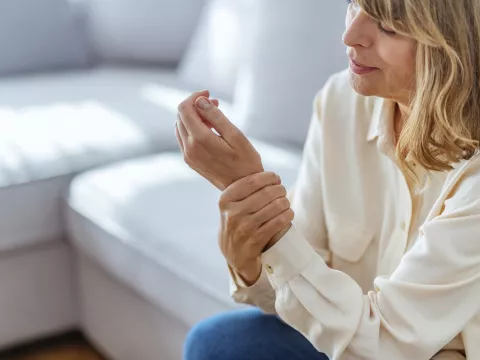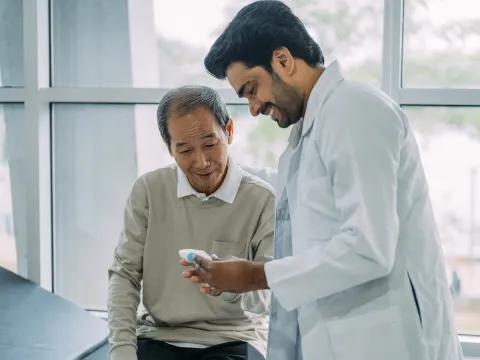- AdventHealth

Hand or finger arthritis can limit your ability to live your best, active life. And if you can’t open a jar, grip your grocery bags or write a letter to a loved one without wincing in pain, it might be time to seek some solutions that may help. Many of these treatments are even safe and effective without surgery.
In fact, Nicholas J. Newsum, MD, board-certified orthopedic surgeon with fellowship training in hand, wrist, elbow and microsurgery, spoke to us about these five nonsurgical treatments for hand and finger arthritis.
Diagnosing Hand and Finger Arthritis
“First, it’s important to correctly diagnose hand or finger arthritis,” advises Dr. Newsum. “Sometimes, patients experience hand or finger pain or stiffness and assume it’s arthritis, but there are other conditions that can cause these symptoms,” he adds.
In addition to arthritis, two other common causes of hand and finger pain include trigger finger and carpal tunnel syndrome.
“Trigger finger is a tendonitis of the finger’s flexor tendons, whereas carpal tunnel is caused by compression of a nerve in the hand,” explains Dr. Newsum.
“Carpal tunnel usually causes numbness, tingling or electric shooting nerve sensations in the hands that can be worse at night or aggravated by certain activities, but it can present without numbness and be mistaken for arthritis, too.”
With trigger finger, pain is usually experienced in the palm of the hand at the base of the fingers. The finger can “click” and even get stuck in a particular position or just may cause stiffness with difficulty bending the fingers.
“Clicking or sticking of a finger is a distinct symptom of trigger finger and not arthritis,” clarifies Dr. Newsum.
Risk Factors for Hand and Finger Arthritis
According to Dr. Newsum, finger or hand arthritis can occur years after of an old injury, but most of the time, it affects people age 50 and older.
“By age 60, 70% of people will have arthritis based on X-rays. By age 75, 90% have arthritis on X-rays, but the important thing to note is that many don’t have severe symptoms and are not debilitated by it.”
If you do, however, it’s important to get medical help to find your path toward relief.
Other factors that can increase your risk of arthritis (or pain and swelling) in your hands and fingers include:
- Diabetes
- Obesity
- Hypothyroidism
- Autoimmune disease
- Repetitive movements
- History of hand or finger trauma
Symptoms of Finger or Hand Arthritis
Dr. Newsum notes that arthritis of the fingers or hands can cause symptoms that may be more exaggerated in the morning or during activity, and include:
- Pain
- Swelling
- Stiffness
- Enlarged bumps at the finger’s knuckles
It’s also important to distinguish between the different types of hand or finger arthritis.
Dr. Newsum explains, “Osteoarthritis affects the middle knuckles and knuckles near the nails and can appear as large bumps on the knuckle, which are bone spurs that are caused from bone rubbing on bone when the joint moves.”
Rheumatoid arthritis, on the other hand, is an autoimmune disease that attacks tendons, ligaments, the joint lining and bones.
Nonsurgical Treatments for Finger and Hand Arthritis
Treatment for finger or hand arthritis is personalized to each person. One of the first things that Dr. Newsum considers when customizing a treatment plan is whether or not one or more joints are affected.
Here are five nonsurgical treatments that Dr. Newsum often recommends to his patients.
1. Finger or Hand Splint
“One conservative treatment can be a temporary splint worn just at night,” says Dr. Newsum.
This can be helpful for individuals who have multiple fingers affected.
“Night splints help the hand and fingers rest in a neutral position. It keeps the fingers slightly bent but the hand open. Splinting can be effective for both rheumatoid and osteoarthritis,” he adds.
2. Topical or Oral Nonsteroidal Anti-inflammatory Medications
Dr. Newsum explains that topical over-the-counter anti-inflammatory medications in the form of gels or creams can be even more effective (and safer) than similar medications taken by mouth.
“Since the finger joints are right under the skin, topical anti-inflammatories can deliver the active ingredient quite well and even offer less side effects compared to oral anti-inflammatories.”
Though, oral anti-inflammatories can be an effective treatment, too, if needed.
“Your doctor can help you determine which is best for you,” says Dr. Newsum.
3. Cortisone Injection
A cortisone injection can be an effective treatment for hand or finger arthritis.
“This injection contains a steroid that can calm inflammation, and this treatment is good for people with a single joint affected, not more widespread arthritis in more than one finger or both hands,” Dr. Newsum states.
4. Paraffin Wax
You might think this seems like just a relaxing spa treatment, but there’s a therapeutic benefit as well.
Dr. Newsum explains, “Paraffin wax machines can be a really helpful treatment to help calm down inflammation in the hands and fingers. I often advise patients to use it two times per day for about 10 minutes each treatment. By moving your hand around in the warm wax, it can decrease pain and inflammation, warm up ligaments and joints and improve mobility.”
This treatment can also help with other hand or finger injuries, dislocations or general stiffness.
5. Glucosamine Chondroitin Supplements
Dr. Newsum says that there’s moderate scientific evidence to show that the over-the-counter supplement glucosamine chondroitin may be helpful in alleviating the symptoms of arthritis.
This is because glucosamine and chondroitin are natural components of cartilage, which is the tissue that cushions all of the body’s joints. It’s thought that this supplement could help in regenerating cartilage, which is especially damaged in osteoarthritis.
As with all over-the-counter vitamins and supplements, it’s important to talk to your doctor before taking glucosamine chondroitin to ensure it’s safe for you.
Why It’s Important to Trust a Hand and Finger Expert
When you’re looking for an expert to guide you to the answers and relief you need, it’s important to trust a doctor with specialized knowledge and training.
When asked about his expertise and training, Dr. Newsum explained, “Two important things to look for in your surgeon are whether they are fellowship-trained and board-certified in their specialty. Meeting the requirements means your doctor has had very specific training in the anatomy, pathophysiology, treatments and the latest nonsurgical surgical techniques to heal a number of conditions that affect the arm, hand and fingers, and that they are up to date on the latest treatments. I focus my time on my specialty exclusively in order to provide evidence-based treatment to both adults and children and deliver expert, compassionate care.”
And when asked why he loves to do what he does, Dr. Newsum described two motivating factors: excellent mentors throughout his training and career, and helping people quickly regain their functioning again.
Dr. Newsum concludes, “We use our hands for everything, so I get to make an impact in peoples’ lives that makes a big difference. I really think my specialty and subspecialty reflect the core of values of modern medicine: to reduce pain and restore function.”
If you’re experiencing pain or stiffness in your fingers or hands, turn to our experts for help. Learn more about AdventHealth’s Hand to Shoulder Center experts.




